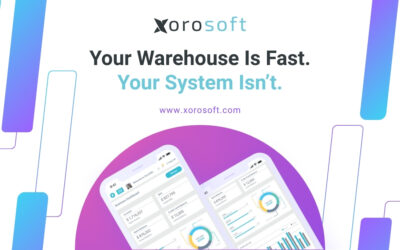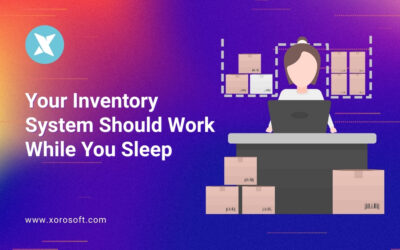
A warehouse management system (WMS) is a software application that helps manage the day-to-day operations of a warehouse. It is designed to optimize inventory control and management, order fulfillment, and distribution processes. WMSs can help streamline the process of receiving and shipping goods, reduce inventory costs, and improve the accuracy of inventory data.
Types of Warehouse Management Systems
Integrated Vs. Standalone WMS
There are two types of warehouse management system software you can use to stay on top of all of your incoming and outgoing product operations.
An Integrated WMS is normally an add-on from your existing Enterprise Resource Planning (ERP) provider. ERP systems manage invoicing, accounting and tracking inventory. The warehouse management system takes the orders and directs the order picking process, inventory and receiving and shipping of products. When everything is able to integrate into one system, it’s much easier to keep track of which orders are best to invest money in.
If you have a product that’s selling very well but has a low profit margin, you could choose to restock a product with a higher profit and slightly lower sales instead. You can keep an eye on all of these financial analytics with an integrated warehouse management system.
A Standalone warehouse management system is feature-rich software that primarily serves the function of warehouse management. Therefore, it might have limited functionality for other aspects of your business, such as inventory or accounting. Since it is tailored to warehouse management, this type of WMS can have advanced reporting features that will help you level up your warehouse.
Overall, it depends on how you manage priorities in your warehouse.
On-Premises Vs. Cloud-Based WMS
In basic terms, an On-premises WMS is one in which you are responsible for hosting and maintaining both the hardware and software associated with your system. While this gives you complete control over things like uptime and security, it also comes with a large upfront cost because you are responsible for all of the components. You will also need to keep your WMS regularly maintained.
While very small businesses can be comfortable using on-premises WMS, managing everything yourself can be a headache. Alternatively, Cloud-based WMS systems are typically charged on a subscription basis, but they are hosted on a remote server. Things like bug fixes and software updates are handled by the vendor, and you typically get a guaranteed level of service uptime when you sign up.
The more an online retail business grows, the more you need to assess the most effective way to manage all of the products. Customers have high expectations when it comes to shipping and even order packaging these days, so it’s important to eliminate confusion in the warehouse. Saving all the time and resources involved in on-premises systems can be a good way of doing just that.
What are the primary functions of a warehouse management system (WMS)?
A Warehouse Management System (WMS) is a computerized system used to streamline and optimize the operations of a warehouse. It helps to manage the movement of materials into, through, and out of a warehouse. The key functions of a WMS include:
- Inventory Management: The WMS tracks inventory information and provides detailed stock tracking capabilities. It also helps to manage inventory levels and alert managers when stock is running low.
- Order Management: The WMS helps to manage orders, from receiving orders and tracking them throughout the fulfillment process to shipping them out. It also provides accurate order picking, packing and shipping information.
- Warehouse Optimization: The WMS helps to optimize the performance of the warehouse by providing route optimization, slotting optimization, and labour optimization.
- Labor Management: The WMS assists in tracking labour hours and performance. It also helps to ensure that the workers are performing their tasks efficiently and meeting productivity standards.
- Automation: The WMS helps to automate tasks such as order picking, packing and shipping. This helps to increase efficiency and accuracy while reducing labour costs.
Overall, a Warehouse Management System is a powerful tool for managing the processes and operations within a warehouse. It helps to streamline operations, optimize performance, and reduce labour costs.
Top 5 processes that a WMS can automate
- Order picking and packing: Automating order picking and packing with a WMS can help reduce errors, speed up the process and make it more efficient.
- Inventory tracking and management: A WMS can help track and manage inventory in real time, giving you the most up-to-date information on stock levels.
- Warehousing and storage: Automating warehousing and storage processes with a WMS can help streamline the movement of goods from one location to another, and reduce the need for manual labour.
- Shipping and delivery: Automating the shipping and delivery process with a WMS can help ensure that shipments are sent out on time and accurately tracked.
- Returns management: Automating returns management with a WMS can help you keep track of returned items and manage the return process more efficiently.
Why is it necessary for ERP systems to integrate with WMS?
ERP systems need to integrate with WMS (Warehouse Management Systems) in order to maintain a full view of inventory, track stock levels and order fulfillment, and provide a single source of truth for inventory data. By integrating WMS with ERP systems, businesses can ensure that their stock levels are accurately reflected in the system and that their inventory data is up-to-date, enabling them to make informed decisions about how to manage their stock. Additionally, ERP systems can use the data from WMS to generate reports and process orders more efficiently, allowing for better customer service and improved customer satisfaction.
With ERP System like Xorosoft, you don’t have to integrate with any external WMS as Xorosoft comes with an inbuilt Warehouse Management System.
Top 3 Benefits of having a WMS built within your ERP
- No need to manage the Integration – If you have an ERP system that includes a Warehouse Management System (WMS), then there is no need to manage integration separately. This can save you time and money while ensuring that your warehouse operations are running smoothly and efficiently.
- Improved efficiency – Integrating a WMS with an ERP system can help streamline supply chain operations by providing real-time control of inventory and streamlining order fulfillment processes. This can help reduce labor costs, as well as increase accuracy and efficiency.
- Improved inventory accuracy – By giving users access to real-time inventory information, a WMS built within your ERP can help reduce the margin of error in tracking, managing and replenishing stock. This helps ensure that you always have the right amount of inventory on hand.
What are the steps involved in implementing a WMS System?
Implementing a Warehouse Management System (WMS) can be a complex process. Here are the steps involved to ensure a successful transition:
- Identify Business Objectives: The first step is to clearly identify your business objectives and the desired outcomes of the system. This will help you to determine the features and modules that you will need.
- Understand Your Warehouse: Once you know what you need, you need to understand your warehouse operations. This includes understanding the layout, processes, and equipment.
- Choose the Right System: After understanding your needs and processes, you can begin to research and select the right system for your warehouse. Consider factors such as scalability, integration, price, and features.
- Develop Implementation Plan: Develop an implementation plan that includes a timeline and budget. Make sure to include training and other important activities that need to be completed.
- Execute the Plan & Test: Once the plan is in place, you can begin the implementation. This includes setting up the system, configuring it, and testing it to ensure it meets your needs.
- Train Employees: Training is essential to ensure that the WMS system is used properly. Make sure to provide adequate training to all relevant employees.
- Ongoing Support: After the system is up and running, you will need to provide ongoing support to ensure its success. This includes making updates, troubleshooting, and providing ongoing training.
What is the average timeline for Implementing a WMS system?
The average timeline for implementing an ERP system typically depends on the size and complexity of the system. Generally, it can range anywhere from 4-6 months. The timeline will also depend on the complexity of the organization’s current setup, the number of users, and the amount of data that needs to be migrated to the new system. Working with an experienced implementation partner can help you make sure the process runs smoothly and that you get the most out of your ERP system.
What are the costs involved in Implementing a WMS system?
The cost of implementing a Warehouse Management System (WMS) will depend on a variety of factors, such as the size of the warehouse and the complexity of the system. Generally speaking, the cost of a WMS system will include licensing fees, software and hardware costs, installation and customization costs, and the cost of training personnel. Depending on the features and capabilities of the system, the cost can range from a few thousand dollars to several hundred thousand dollars.
What are the key aspects of a WMS that cannot be overlooked while making a decision?
When selecting a Warehouse Management System (WMS), there are several key functions that should not be overlooked. First, you want to make sure the WMS is able to integrate with existing systems, such as your ERP and other 3PLs, to ensure seamless data sharing. Secondly, you should pay attention to the reporting capabilities of the system, as this will provide visibility into the warehouse operations. Thirdly, consider the scalability of the system, as your warehouse operations may change over time. Fourth, you should evaluate the user-friendliness of the system, to ensure your team is able to use the system efficiently. Finally, make sure to read reviews from other users to best assess the WMS’ performance and capabilities.
What are the top questions you need to ask your WMS vendor?
When considering a WMS vendor, it’s important to ask the right questions to ensure you’re getting the best possible solution. Here are some of the top questions to ask:
- Does the WMS integrate with my existing systems, such as ERP/accounting, inventory management, shipping, and 3PLs?
- How well does the WMS handle inventory tracking?
- How configurable is the WMS?
- What types of reporting are available?
- What are the costs associated with the WMS?
- How user-friendly is the system?
- What type of customer service and support is offered?
- What are the scalability and upgradability options?
- What are the security protocols in place?
- Does the WMS offer mobile capabilities?
Top 10 reasons why WMS implementations fail
- Poor planning: Without proper planning, organizations can overlook key tasks and activities that are necessary for successful implementation.
- Insufficient technical resources: Implementing a WMS requires a lot of technical knowledge and resources. If an organization does not have the required technical resources, then it can negatively affect the implementation process.
- Poor communication between stakeholders: To ensure a successful WMS implementation, all stakeholders need to be on the same page. If communication between stakeholders is not clear, then it can lead to delays and errors.
- Lack of training: Without adequate training, users may not understand how to use the system properly and this can lead to errors and inefficiencies.
- Unclear expectations: If the expectations for the implementation are not set out clearly, then it may not be successful.
- Poor data quality: Poor data quality can lead to incorrect information being inputted into the system, resulting in errors and delays.
- Inadequate testing: Testing the system is an important step in the implementation process, and if it is not done properly, it can lead to errors and delays.
- Not addressing the user experience: If the user experience is not taken into account, then users may not find the system easy to use, resulting in errors and inefficiencies.
- Not following best practices: Following best practices will ensure that the system is implemented correctly and efficiently.
- Not using an experienced implementation partner: Having an experienced implementation partner can help ensure that the system is implemented correctly and efficiently.
The dangers of not having a Warehouse Management System
Not having a Warehouse Management System (WMS) can lead to a variety of risks associated with managing inventory, controlling costs, and improving customer service. Without a WMS, businesses may not be able to accurately track the movement and location of inventory in their warehouse, leading to overstocking or stockouts of products. Additionally, manual processes can lead to higher labour costs and slower order processing times, resulting in reduced customer satisfaction. Finally, without a WMS, businesses may struggle to accurately monitor and report their inventory levels, leading to inaccurate forecasts and inefficient supply chain operations.
Is my business too small for implementing a WMS?
That’s a great question. It really depends on the size and complexity of your business. A Warehouse Management System (WMS) can be beneficial for any business of any size. It can help you better control and manage inventory, automate processes, and increase efficiency. If you have a small business, a basic WMS system may be all you need. However, if you have a larger business with more complex processes, you may need a more advanced WMS. Doing some research and evaluation to determine what type of WMS would be best for your business. XoroWMS ( a WMS solution powered by Xorosoft) comes in 3 different tiers: Partial WMS, Full WMS and Advanced WMS which can cater to any size of business.
What kind of WMS systems a 3PL (Third Party Logistics) can use?
A 3PL can use a variety of Warehouse Management Systems (WMS) to improve efficiency and accuracy in their warehouse operations. WMS software can help manage and optimize inventory, order fulfillment, shipping, receiving, and other warehouse operations. Popular WMS solutions include Xorosoft, HighJump, Oracle, Manhattan Associates, and SAP. Each system offers its own set of features and advantages, so it’s important for a 3PL to evaluate its specific needs and find the best solution for its business. Most importantly, it should have a 3PL billing module.
A Warehouse Management System (WMS) with a 3PL billing module can help streamline the costly and complex billing process for third-party logistics (3PL) providers. By having a 3PL billing module in a WMS, 3PL providers are able to quickly and accurately generate invoices that include all of the necessary details, such as order numbers, customer information, and payment terms. This saves time, reduces errors, and ensures that 3PL providers are accurately compensated for their services. Additionally, the 3PL billing module can help 3PL providers collect data on their operations, allowing them to make more informed business decisions.
What are the top 10 workflows that a WMS can automate for Ecommerce Brands and Wholesale Distributors?
Automating workflows with a Warehouse Management System (WMS) can help eCommerce brands optimize their operations and improve efficiency. Here are the top 10 workflows that can be automated with a WMS:
- Inventory tracking: Automatically track and monitor inventory levels and locations, including the ability to detect discrepancies.
- Order fulfillment: Automate the process of picking, packing, and shipping orders.
- Returns processing: Automate the process of receiving and processing returns.
- Cross-docking: Automatically route incoming products to their respective outgoing shipments without the need for extra handling.
- Cycle counting: Automate periodic inventory counts to detect discrepancies and ensure accuracy.
- Yard management: Automate the process of receiving, storing, and shipping yard products.
- Slotting: Automatically optimize item locations in the warehouse based on order frequency and volume.
- Re-stocking: Automate the process of replenishing inventory in order to maintain optimal stock levels.
- Quality control: Automate the process of inspecting and tracking product quality, including the ability to detect defects.
- Warehouse Analytics: Automatically track and monitor warehouse performance metrics in order to identify areas for improvement.
Top reasons to select Xorosoft over any other WMS Vendor
XoroWMS is a great WMS solution for any business looking to streamline its operations. Here are some of the top reasons why you should consider Xorosoft as your WMS vendor:
- Comprehensive features & tools: Xorosoft offers a comprehensive range of features and tools to help you manage your warehouse operations. From inventory tracking to barcode scanning, you can be sure that Xorosoft has the right tools to help you optimize your warehouse management.
- Scalable & secure: Xorosoft is built for scalability and offers secure cloud-based solutions. This means that you can easily scale up or down with your business needs, without worrying about security.
- Automated workflows: Xorosoft offers a range of automated workflows to help you streamline your warehouse operations. This includes automated shipping and purchasing, as well as automated data entry and reporting.
- Advanced analytics: Xorosoft offers advanced analytics to help you better understand your warehouse operations. This includes real-time insights into stock availability, demand forecasting, and more, so that you can make better decisions.
- Flexible pricing: Xorosoft offers flexible pricing plans to meet the needs of any business. This means that you can select the pricing plan that works best for your budget and operations.
Overall, XoroWMS is an excellent choice for any business looking to streamline their warehouse operations. It offers a comprehensive range of features and tools, secure cloud-based solutions, automated workflows, advanced analytics, and flexible pricing.









